engine TOYOTA RAV4 PLUG-IN HYBRID 2022 Owners Manual
[x] Cancel search | Manufacturer: TOYOTA, Model Year: 2022, Model line: RAV4 PLUG-IN HYBRID, Model: TOYOTA RAV4 PLUG-IN HYBRID 2022Pages: 662, PDF Size: 163.06 MB
Page 6 of 662
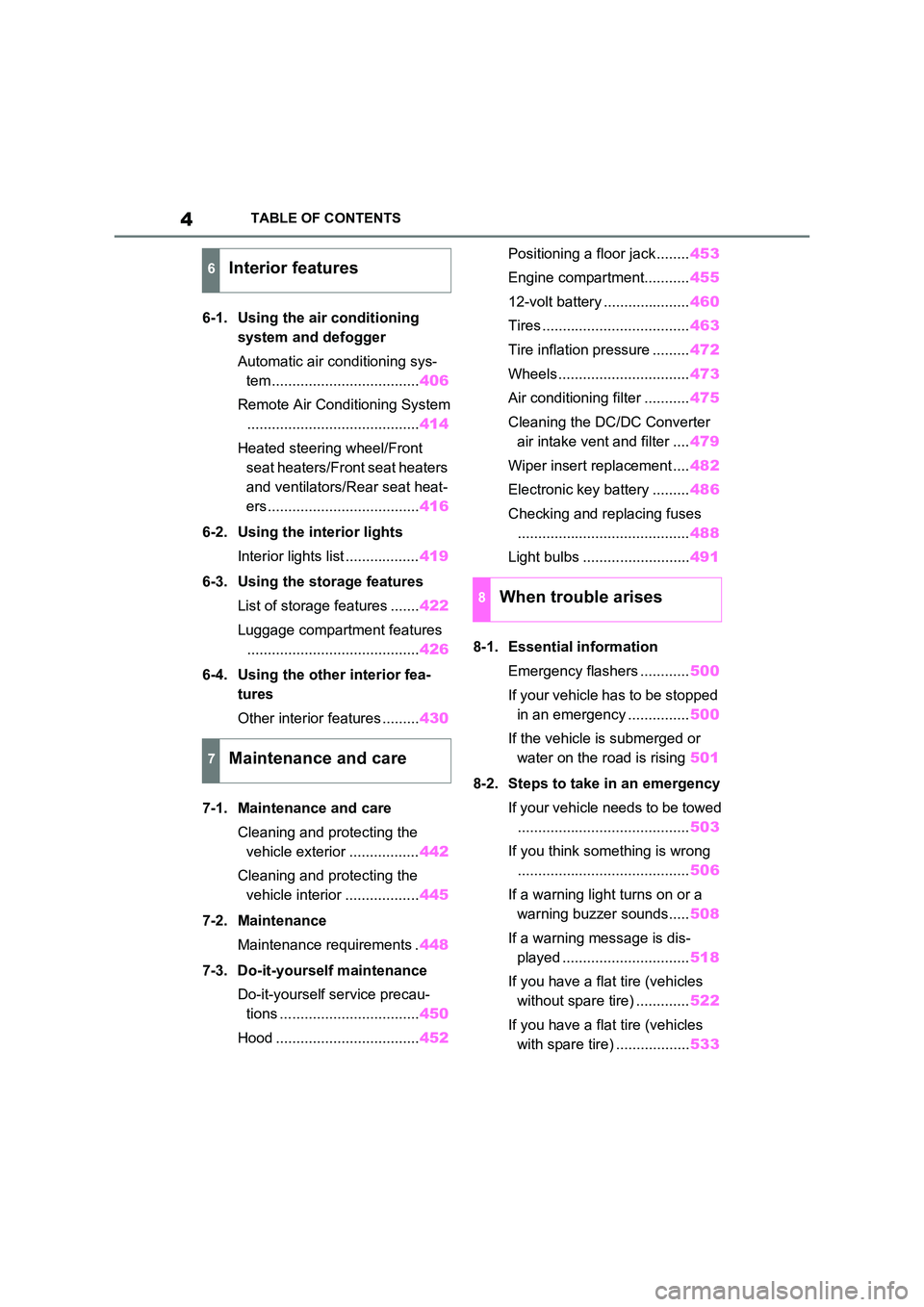
4TABLE OF CONTENTS
6-1. Using the air conditioning
system and defogger
Automatic air conditioning sys-
tem .................................... 406
Remote Air Conditioning System
.......................................... 414
Heated steering wheel/Front
seat heaters/Front seat heaters
and ventilators/Rear seat heat-
ers..................................... 416
6-2. Using the interior lights
Interior lights list .................. 419
6-3. Using the storage features
List of storage features ....... 422
Luggage compartment features
.......................................... 426
6-4. Using the other interior fea-
tures
Other interior features ......... 430
7-1. Maintenance and care
Cleaning and protecting the
vehicle exterior ................. 442
Cleaning and protecting the
vehicle interior .................. 445
7-2. Maintenance
Maintenance requirements . 448
7-3. Do-it-yourself maintenance
Do-it-yourself service precau-
tions .................................. 450
Hood ................................... 452
Positioning a floor jack ........ 453
Engine compartment........... 455
12-volt battery ..................... 460
Tires .................................... 463
Tire inflation pressure ......... 472
Wheels ................................ 473
Air conditioning filter ........... 475
Cleaning the DC/DC Converter
air intake vent and filter .... 479
Wiper insert replacement .... 482
Electronic key battery ......... 486
Checking and replacing fuses
.......................................... 488
Light bulbs .......................... 491
8-1. Essential information
Emergency flashers ............ 500
If your vehicle has to be stopped
in an emergency ............... 500
If the vehicle is submerged or
water on the road is rising 501
8-2. Steps to take in an emergency
If your vehicle needs to be towed
.......................................... 503
If you think something is wrong
.......................................... 506
If a warning light turns on or a
warning buzzer sounds..... 508
If a warning message is dis-
played ............................... 518
If you have a flat tire (vehicles
without spare tire) ............. 522
If you have a flat tire (vehicles
with spare tire) .................. 533
6Interior features
7Maintenance and care
8When trouble arises
Page 9 of 662
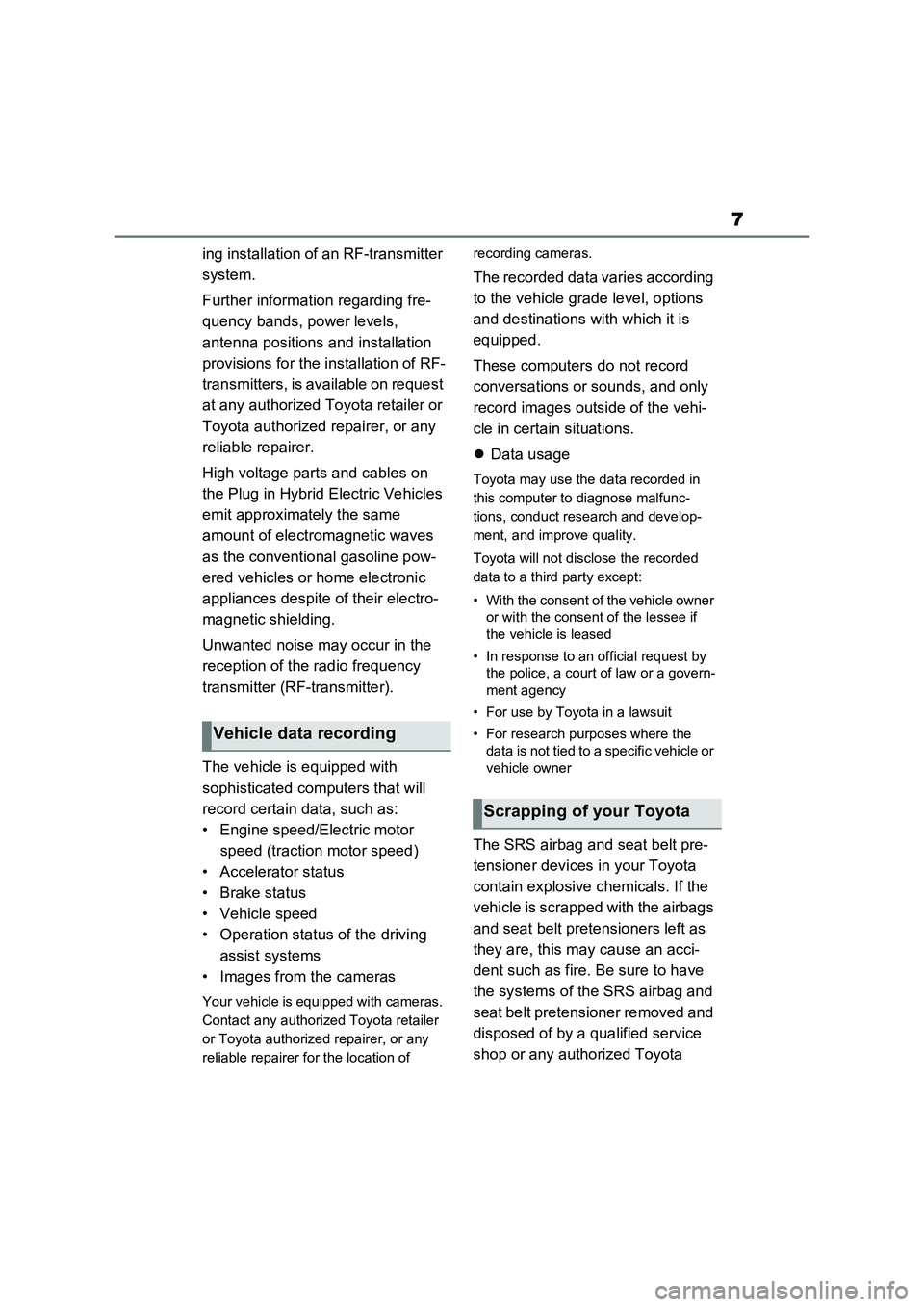
7
ing installation of an RF-transmitter
system.
Further information regarding fre-
quency bands, power levels,
antenna positions and installation
provisions for the installation of RF-
transmitters, is available on request
at any authorized Toyota retailer or
Toyota authorized repairer, or any
reliable repairer.
High voltage parts and cables on
the Plug in Hybrid Electric Vehicles
emit approximately the same
amount of electromagnetic waves
as the conventional gasoline pow-
ered vehicles or home electronic
appliances despite of their electro-
magnetic shielding.
Unwanted noise may occur in the
reception of the radio frequency
transmitter (RF-transmitter).
The vehicle is equipped with
sophisticated computers that will
record certain data, such as:
• Engine speed/Electric motor
speed (traction motor speed)
• Accelerator status
• Brake status
• Vehicle speed
• Operation status of the driving
assist systems
• Images from the cameras
Your vehicle is equipped with cameras.
Contact any authorized Toyota retailer
or Toyota authorized repairer, or any
reliable repairer for the location of recording cameras.
The recorded data varies according
to the vehicle grade level, options
and destinations with which it is
equipped.
These computers do not record
conversations or sounds, and only
record images outside of the vehi-
cle in certain situations.
Data usage
Toyota may use the data recorded in
this computer to diagnose malfunc-
tions, conduct research and develop-
ment, and improve quality.
Toyota will not disclose the recorded
data to a third party except:
• With the consent of the vehicle owner
or with the consent of the lessee if
the vehicle is leased
• In response to an official request by
the police, a court of law or a govern-
ment agency
• For use by Toyota in a lawsuit
• For research purposes where the
data is not tied to a specific vehicle or
vehicle owner
The SRS airbag and seat belt pre-
tensioner devices in your Toyota
contain explosive chemicals. If the
vehicle is scrapped with the airbags
and seat belt pretensioners left as
they are, this may cause an acci-
dent such as fire. Be sure to have
the systems of the SRS airbag and
seat belt pretensioner removed and
disposed of by a qualified service
shop or any authorized Toyota
Vehicle data recording
Scrapping of your Toyota
Page 15 of 662
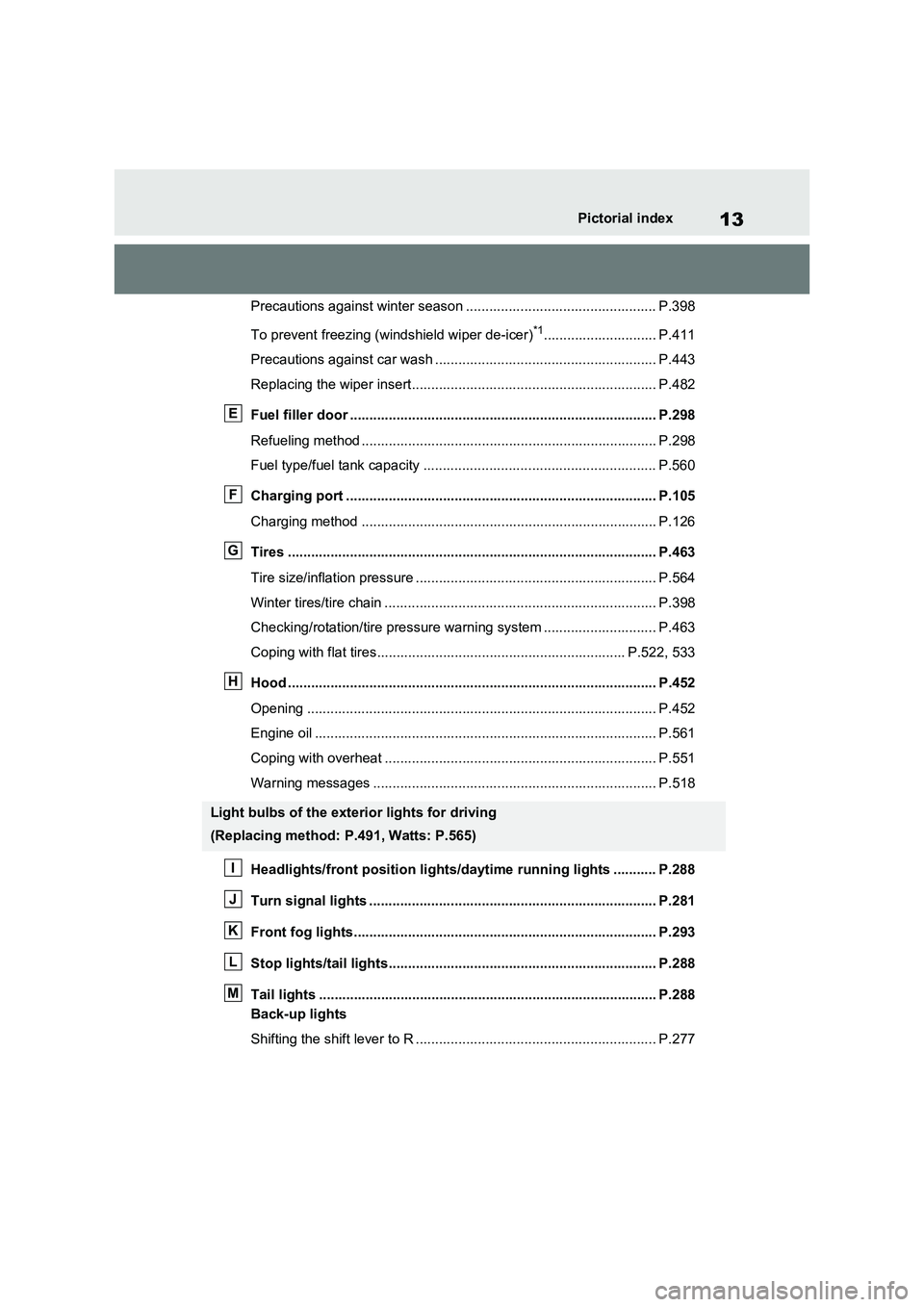
13Pictorial index
Precautions against winter season ................................................. P.398
To prevent freezing (windshield wiper de-icer)
*1............................. P.411
Precautions against car wash ......................................................... P.443
Replacing the wiper insert............................................................... P.482
Fuel filler door ............................................................................... P.298
Refueling method ............................................................................ P.298
Fuel type/fuel tank capacity ............................................................ P.560
Charging port ................................................................................ P.105
Charging method ............................................................................ P.126
Tires ............................................................................................... P.463
Tire size/inflation pressure .............................................................. P.564
Winter tires/tire chain ...................................................................... P.398
Checking/rotation/tire pressure warning system ............................. P.463
Coping with flat tires................................................................ P.522, 533
Hood ............................................................................................... P.452
Opening .......................................................................................... P.452
Engine oil ........................................................................................ P.561
Coping with overheat ...................................................................... P.551
Warning messages ......................................................................... P.518
Headlights/front position lights/daytime running lights ........... P.288
Turn signal lights .......................................................................... P.281
Front fog lights.............................................................................. P.293
Stop lights/tail lights..................................................................... P.288
Tail lights ....................................................................................... P.288
Back-up lights
Shifting the shift lever to R .............................................................. P.277
Light bulbs of the exterior lights for driving
(Replacing method: P.491, Watts: P.565)
E
F
G
H
I
J
K
L
M
Page 43 of 662
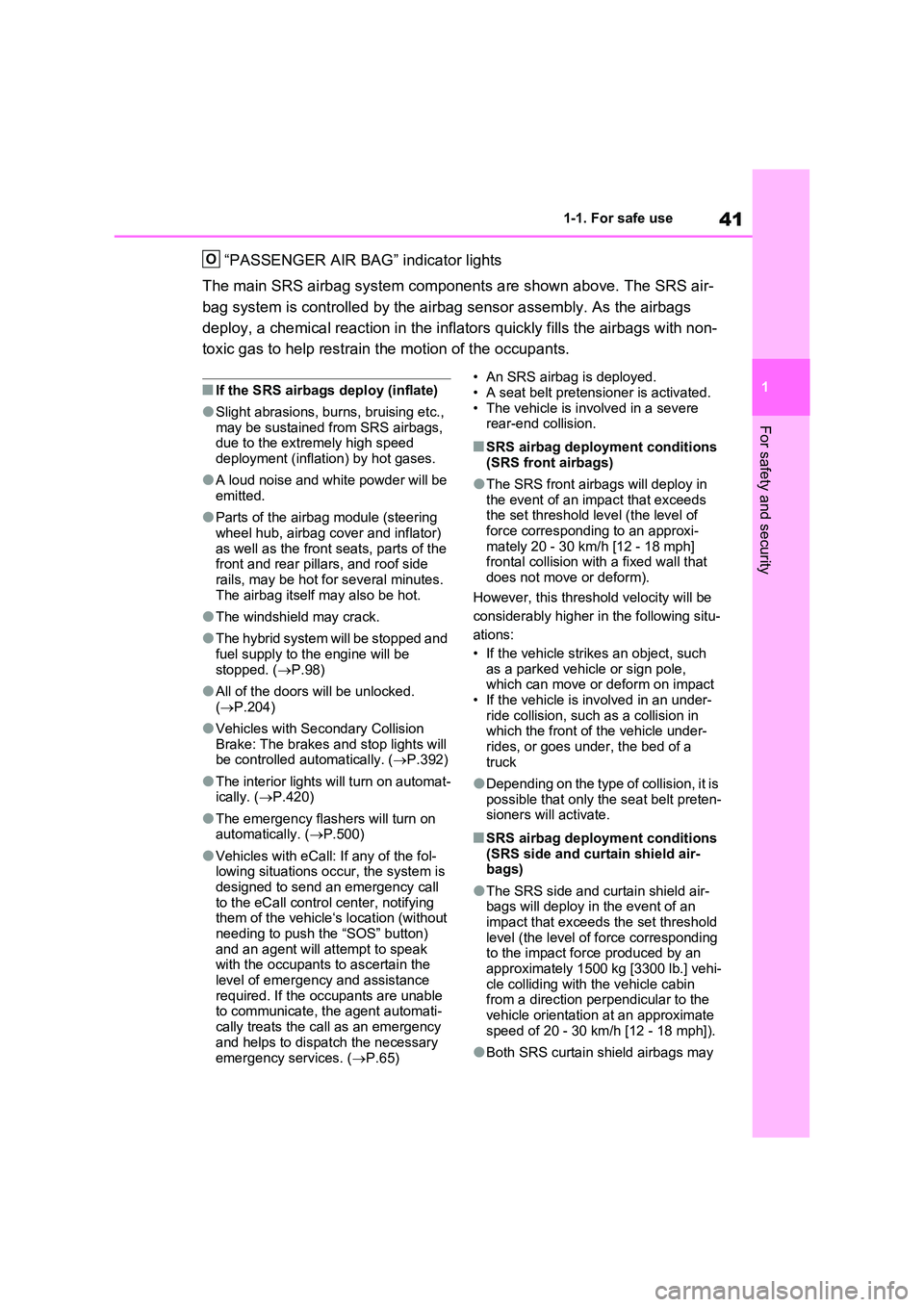
41
1
1-1. For safe use
For safety and security
“PASSENGER AIR BAG” indicator lights
The main SRS airbag system components are shown above. The SRS air-
bag system is controlled by the airbag sensor assembly. As the airbags
deploy, a chemical reaction in the inflators quickly fills the airbags with non-
toxic gas to help restrain the motion of the occupants.
�QIf the SRS airbags deploy (inflate)
�OSlight abrasions, burns, bruising etc., may be sustained from SRS airbags, due to the extremely high speed
deployment (inflation) by hot gases.
�OA loud noise and white powder will be
emitted.
�OParts of the airbag module (steering
wheel hub, airbag cover and inflator) as well as the front seats, parts of the front and rear pillars, and roof side
rails, may be hot for several minutes. The airbag itself may also be hot.
�OThe windshield may crack.
�OThe hybrid system will be stopped and
fuel supply to the engine will be stopped. ( P.98)
�OAll of the doors will be unlocked. ( P.204)
�OVehicles with Secondary Collision Brake: The brakes and stop lights will be controlled automatically. ( P.392)
�OThe interior lights will turn on automat- ically. ( P.420)
�OThe emergency flashers will turn on automatically. ( P.500)
�OVehicles with eCall: If any of the fol- lowing situations occur, the system is
designed to send an emergency call to the eCall control center, notifying them of the vehicle‘s location (without
needing to push the “SOS” button) and an agent will attempt to speak with the occupants to ascertain the
level of emergency and assistance required. If the occupants are unable to communicate, the agent automati-
cally treats the call as an emergency and helps to dispatch the necessary
emergency services. ( P.65)
• An SRS airbag is deployed. • A seat belt pretensioner is activated.
• The vehicle is involved in a severe rear-end collision.
�QSRS airbag deployment conditions
(SRS front airbags)
�OThe SRS front airbags will deploy in
the event of an impact that exceeds the set threshold level (the level of force corresponding to an approxi-
mately 20 - 30 km/h [12 - 18 mph] frontal collision with a fixed wall that does not move or deform).
However, this threshold velocity will be
considerably higher in the following situ-
ations:
• If the vehicle strikes an object, such as a parked vehicle or sign pole, which can move or deform on impact
• If the vehicle is involved in an under- ride collision, such as a collision in which the front of the vehicle under-
rides, or goes under, the bed of a truck
�ODepending on the type of collision, it is possible that only the seat belt preten-sioners will activate.
�QSRS airbag deployment conditions
(SRS side and curtain shield air- bags)
�OThe SRS side and curtain shield air-bags will deploy in the event of an impact that exceeds the set threshold
level (the level of force corresponding to the impact force produced by an approximately 1500 kg [3300 lb.] vehi-
cle colliding with the vehicle cabin from a direction perpendicular to the vehicle orientation at an approximate
speed of 20 - 30 km/h [12 - 18 mph]).
�OBoth SRS curtain shield airbags may
O
Page 86 of 662
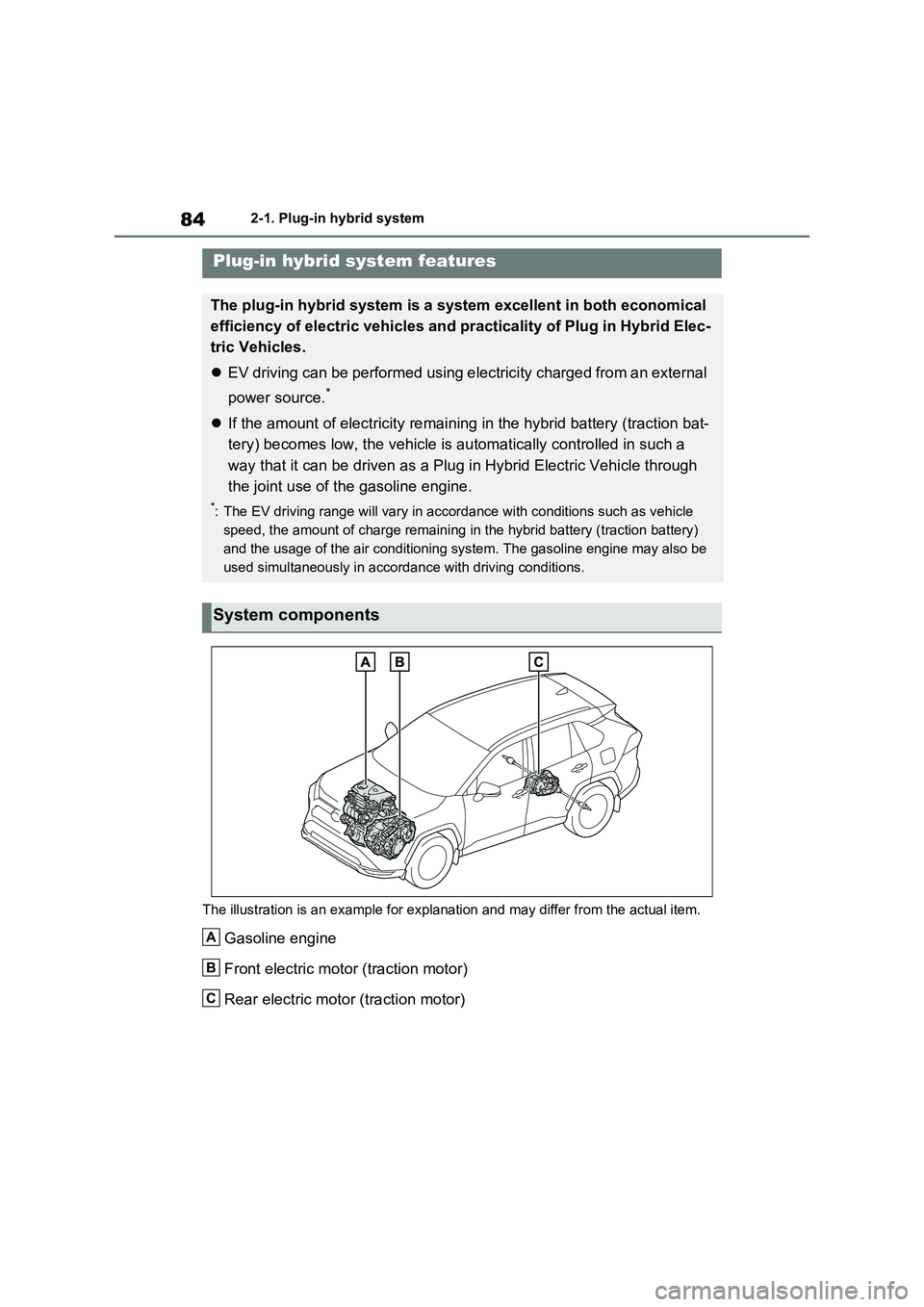
842-1. Plug-in hybrid system
2-1.Plug-in hyb rid s ystem
The illustration is an example for explanation and may differ from the actual item.
Gasoline engine
Front electric motor (traction motor)
Rear electric motor (traction motor)
Plug-in hybrid system features
The plug-in hybrid system is a system excellent in both economical
efficiency of electric vehicles and practicality of Plug in Hybrid Elec-
tric Vehicles.
EV driving can be performed using electricity charged from an external
power source.
*
If the amount of electricity remaining in the hybrid battery (traction bat-
tery) becomes low, the vehicle is automatically controlled in such a
way that it can be driven as a Plug in Hybrid Electric Vehicle through
the joint use of the gasoline engine.
*: The EV driving range will vary in accordance with conditions such as vehicle
speed, the amount of charge remaining in the hybrid battery (traction battery)
and the usage of the air conditioning system. The gasoline engine may also be
used simultaneously in accordance with driving conditions.
System components
A
B
C
Page 87 of 662
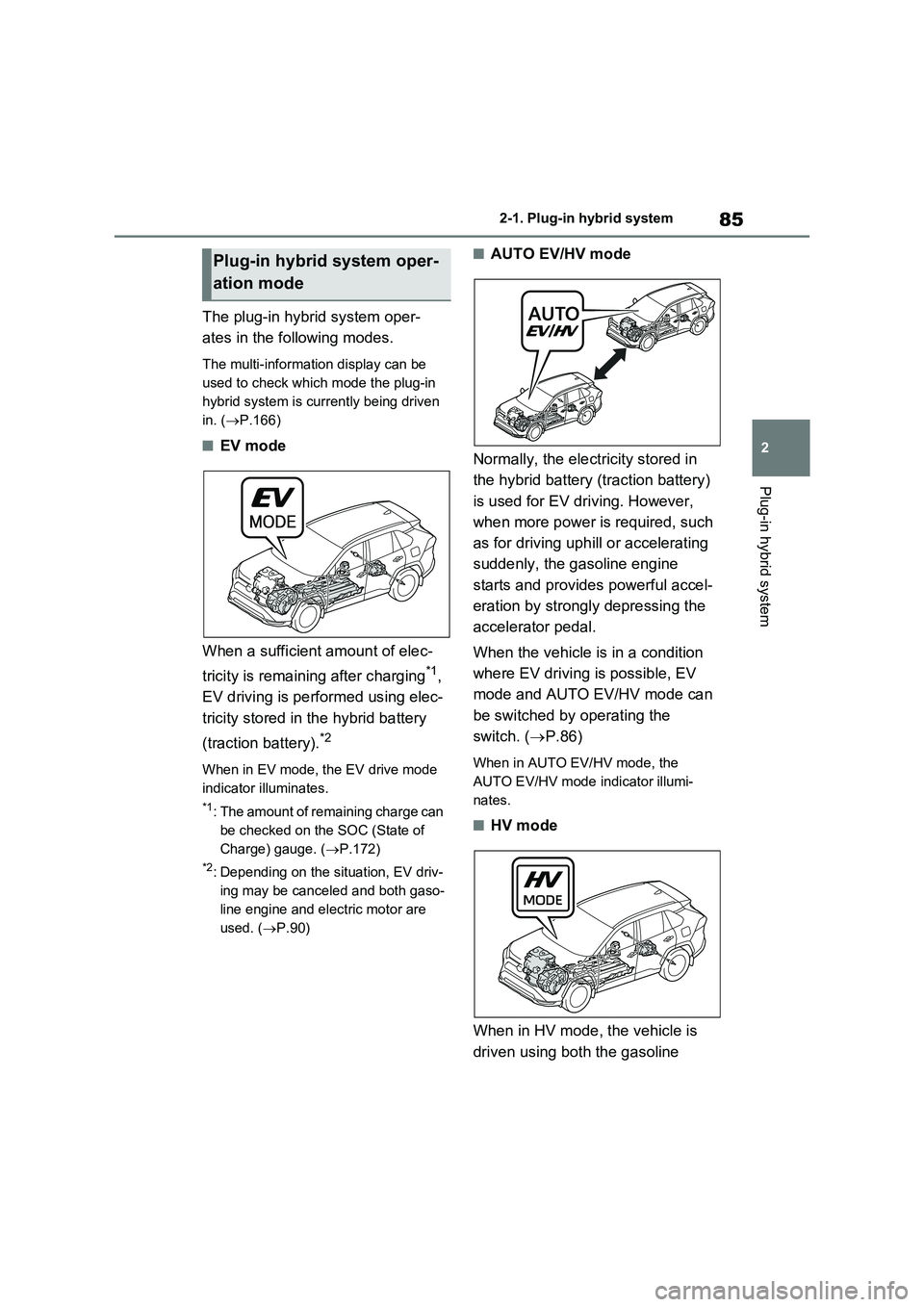
85
2
2-1. Plug-in hybrid system
Plug-in hybrid system
The plug-in hybrid system oper-
ates in the following modes.
The multi-information display can be
used to check which mode the plug-in
hybrid system is currently being driven
in. ( P.166)
�QEV mode
When a sufficient amount of elec-
tricity is remaining after charging*1,
EV driving is performed using elec-
tricity stored in the hybrid battery
(traction battery).*2
When in EV mode, the EV drive mode
indicator illuminates.
*1: The amount of remaining charge can
be checked on the SOC (State of
Charge) gauge. ( P.172)
*2: Depending on the situation, EV driv-
ing may be canceled and both gaso-
line engine and electric motor are
used. ( P.90)
�QAUTO EV/HV mode
Normally, the electricity stored in
the hybrid battery (traction battery)
is used for EV driving. However,
when more power is required, such
as for driving uphill or accelerating
suddenly, the gasoline engine
starts and provides powerful accel-
eration by strongly depressing the
accelerator pedal.
When the vehicle is in a condition
where EV driving is possible, EV
mode and AUTO EV/HV mode can
be switched by operating the
switch. ( P.86)
When in AUTO EV/HV mode, the
AUTO EV/HV mode indicator illumi-
nates.
�QHV mode
When in HV mode, the vehicle is
driven using both the gasoline
Plug-in hybrid system oper-
ation mode
Page 88 of 662
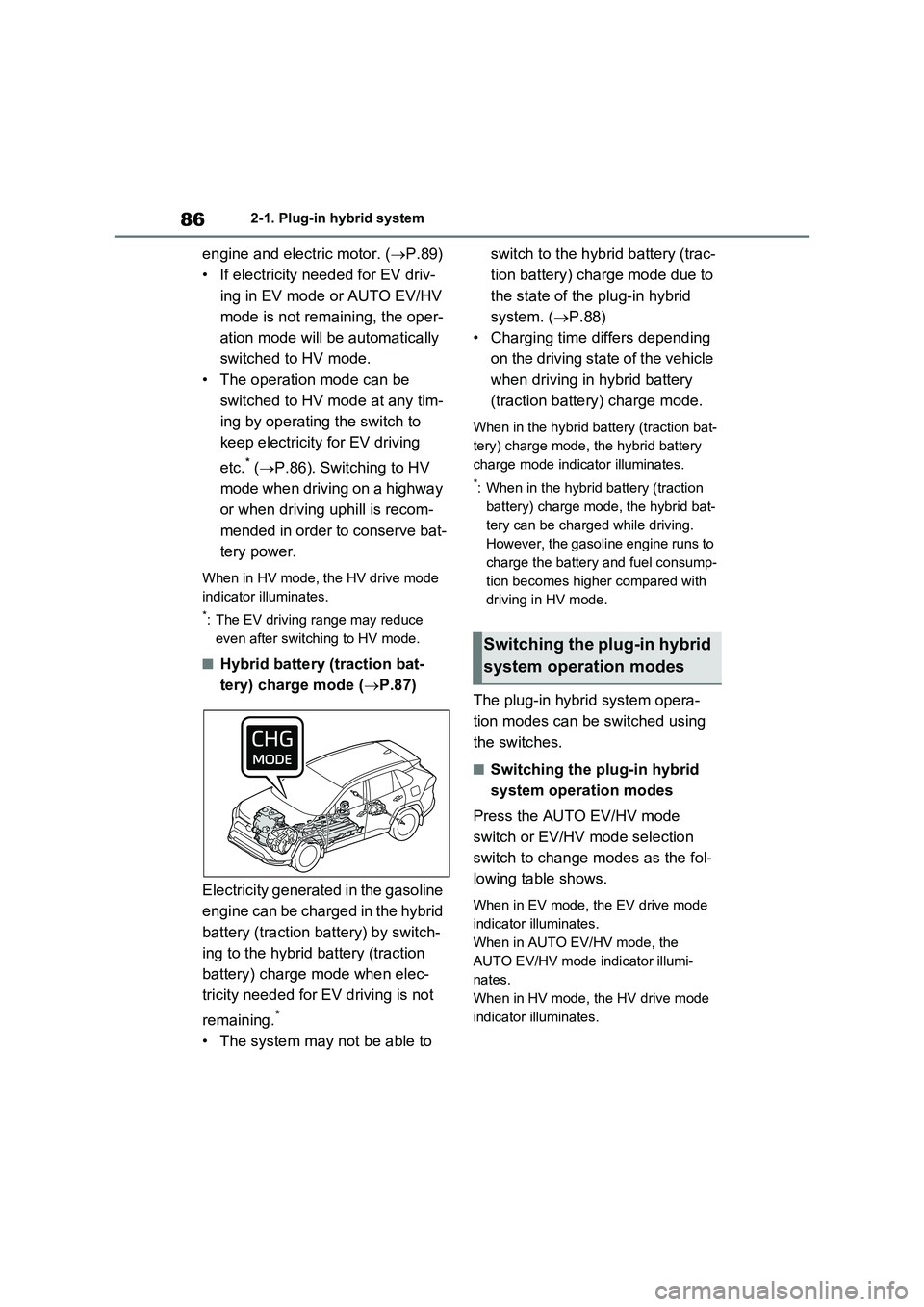
862-1. Plug-in hybrid system
engine and electric motor. (P.89)
• If electricity needed for EV driv-
ing in EV mode or AUTO EV/HV
mode is not remaining, the oper-
ation mode will be automatically
switched to HV mode.
• The operation mode can be
switched to HV mode at any tim-
ing by operating the switch to
keep electricity for EV driving
etc.
* (P.86). Switching to HV
mode when driving on a highway
or when driving uphill is recom-
mended in order to conserve bat-
tery power.
When in HV mode, the HV drive mode
indicator illuminates.
*: The EV driving range may reduce
even after switching to HV mode.
�QHybrid battery (traction bat-
tery) charge mode (P.87)
Electricity generated in the gasoline
engine can be charged in the hybrid
battery (traction battery) by switch-
ing to the hybrid battery (traction
battery) charge mode when elec-
tricity needed for EV driving is not
remaining.
*
• The system may not be able to switch to the hybrid battery (trac-
tion battery) charge mode due to
the state of the plug-in hybrid
system. (P.88)
• Charging time differs depending
on the driving state of the vehicle
when driving in hybrid battery
(traction battery) charge mode.
When in the hybrid battery (traction bat-
tery) charge mode, the hybrid battery
charge mode indicator illuminates.
*: When in the hybrid battery (traction
battery) charge mode, the hybrid bat-
tery can be charged while driving.
However, the gasoline engine runs to
charge the battery and fuel consump-
tion becomes higher compared with
driving in HV mode.
The plug-in hybrid system opera-
tion modes can be switched using
the switches.
�QSwitching the plug-in hybrid
system operation modes
Press the AUTO EV/HV mode
switch or EV/HV mode selection
switch to change modes as the fol-
lowing table shows.
When in EV mode, the EV drive mode
indicator illuminates.
When in AUTO EV/HV mode, the
AUTO EV/HV mode indicator illumi-
nates.
When in HV mode, the HV drive mode
indicator illuminates.
Switching the plug-in hybrid
system operation modes
Page 90 of 662
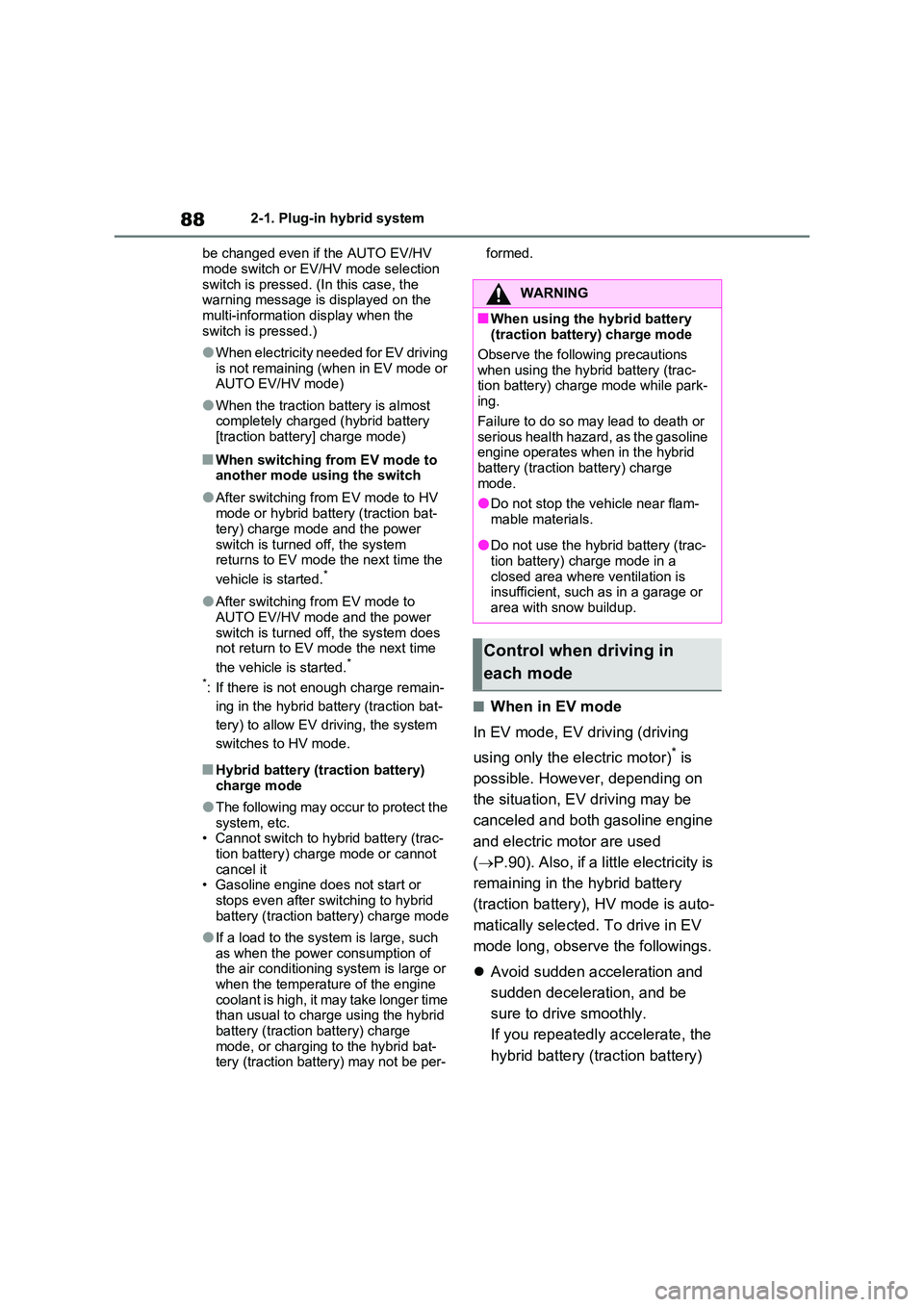
882-1. Plug-in hybrid system
be changed even if the AUTO EV/HV
mode switch or EV/HV mode selection switch is pressed. (In this case, the warning message is displayed on the
multi-information display when the switch is pressed.)
�OWhen electricity needed for EV driving is not remaining (when in EV mode or AUTO EV/HV mode)
�OWhen the traction battery is almost completely charged (hybrid battery
[traction battery] charge mode)
�QWhen switching from EV mode to another mode using the switch
�OAfter switching from EV mode to HV
mode or hybrid battery (traction bat- tery) charge mode and the power
switch is turned off, the system returns to EV mode the next time the
vehicle is started.*
�OAfter switching from EV mode to
AUTO EV/HV mode and the power switch is turned off, the system does not return to EV mode the next time
the vehicle is started.*
*: If there is not enough charge remain-
ing in the hybrid battery (traction bat-
tery) to allow EV driving, the system
switches to HV mode.
�QHybrid battery (traction battery) charge mode
�OThe following may occur to protect the system, etc.• Cannot switch to hybrid battery (trac-
tion battery) charge mode or cannot cancel it• Gasoline engine does not start or
stops even after switching to hybrid battery (traction battery) charge mode
�OIf a load to the system is large, such as when the power consumption of the air conditioning system is large or
when the temperature of the engine coolant is high, it may take longer time than usual to charge using the hybrid
battery (traction battery) charge mode, or charging to the hybrid bat-tery (traction battery) may not be per-
formed.
�QWhen in EV mode
In EV mode, EV driving (driving
using only the electric motor)* is
possible. However, depending on
the situation, EV driving may be
canceled and both gasoline engine
and electric motor are used
( P.90). Also, if a little electricity is
remaining in the hybrid battery
(traction battery), HV mode is auto-
matically selected. To drive in EV
mode long, observe the followings.
Avoid sudden acceleration and
sudden deceleration, and be
sure to drive smoothly.
If you repeatedly accelerate, the
hybrid battery (traction battery)
WARNING
�QWhen using the hybrid battery (traction battery) charge mode
Observe the following precautions
when using the hybrid battery (trac- tion battery) charge mode while park-ing.
Failure to do so may lead to death or serious health hazard, as the gasoline engine operates when in the hybrid
battery (traction battery) charge mode.
�ODo not stop the vehicle near flam-
mable materials.
�ODo not use the hybrid battery (trac-
tion battery) charge mode in a closed area where ventilation is insufficient, such as in a garage or
area with snow buildup.
Control when driving in
each mode
Page 91 of 662
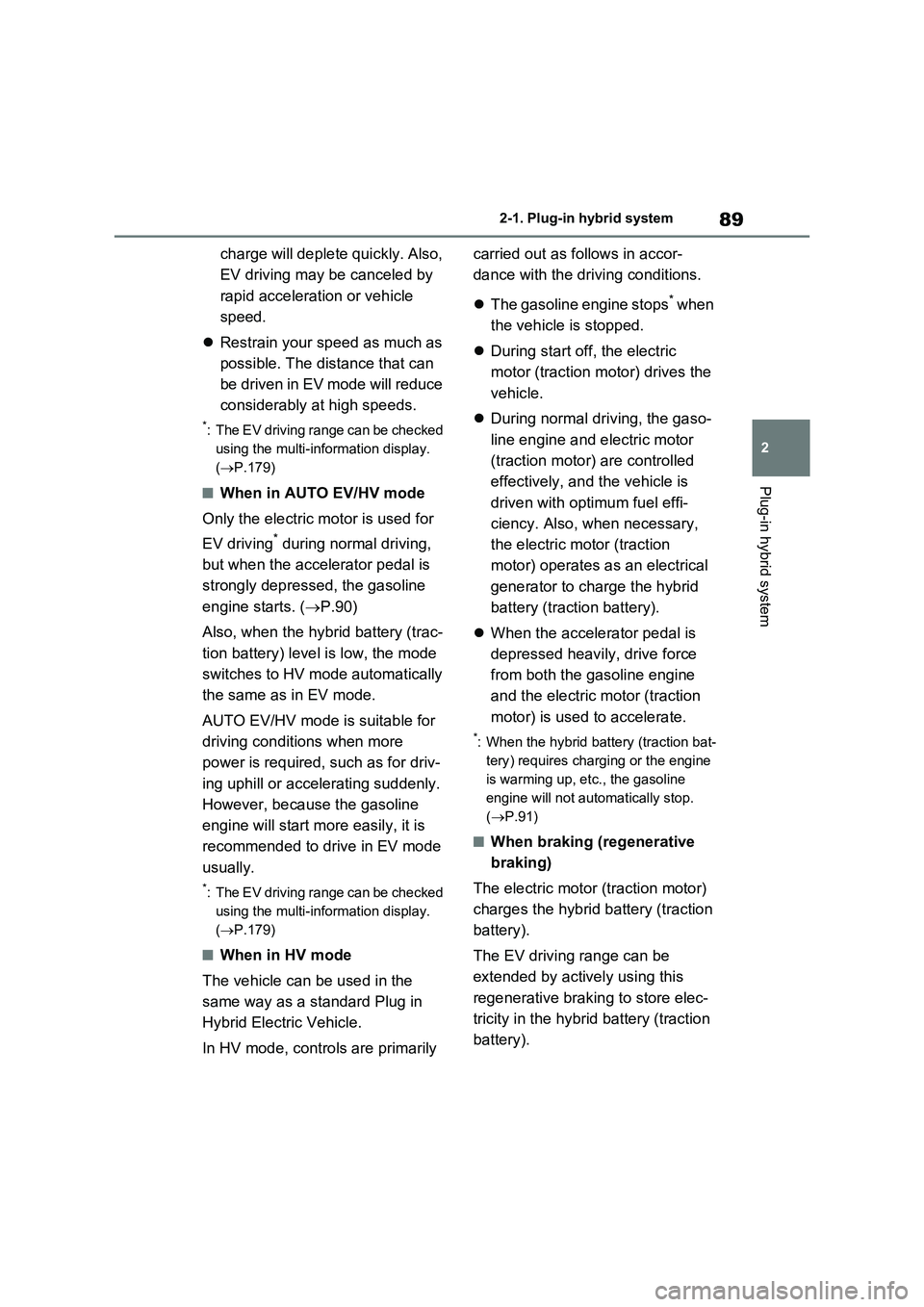
89
2 2-1. Plug-in hybrid system
Plug-in hybrid system
charge will deplete quickly. Also,
EV driving may be canceled by
rapid acceleration or vehicle
speed.
Restrain your speed as much as
possible. The distance that can
be driven in EV mode will reduce
considerably at high speeds.
*: The EV driving range can be checked
using the multi-information display.
(P.179)
�QWhen in AUTO EV/HV mode
Only the electric motor is used for
EV driving
* during normal driving,
but when the accelerator pedal is
strongly depressed, the gasoline
engine starts. (P.90)
Also, when the hybrid battery (trac-
tion battery) level is low, the mode
switches to HV mode automatically
the same as in EV mode.
AUTO EV/HV mode is suitable for
driving conditions when more
power is required, such as for driv-
ing uphill or accelerating suddenly.
However, because the gasoline
engine will start more easily, it is
recommended to drive in EV mode
usually.
*: The EV driving range can be checked
using the multi-information display.
(P.179)
�QWhen in HV mode
The vehicle can be used in the
same way as a standard Plug in
Hybrid Electric Vehicle.
In HV mode, controls are primarily carried out as follows in accor-
dance with the driving conditions.
The gasoline engine stops
* when
the vehicle is stopped.
During start off, the electric
motor (traction motor) drives the
vehicle.
During normal driving, the gaso-
line engine and electric motor
(traction motor) are controlled
effectively, and the vehicle is
driven with optimum fuel effi-
ciency. Also, when necessary,
the electric motor (traction
motor) operates as an electrical
generator to charge the hybrid
battery (traction battery).
When the accelerator pedal is
depressed heavily, drive force
from both the gasoline engine
and the electric motor (traction
motor) is used to accelerate.
*: When the hybrid battery (traction bat-
tery) requires charging or the engine
is warming up, etc., the gasoline
engine will not automatically stop.
(P.91)
�QWhen braking (regenerative
braking)
The electric motor (traction motor)
charges the hybrid battery (traction
battery).
The EV driving range can be
extended by actively using this
regenerative braking to store elec-
tricity in the hybrid battery (traction
battery).
Page 92 of 662
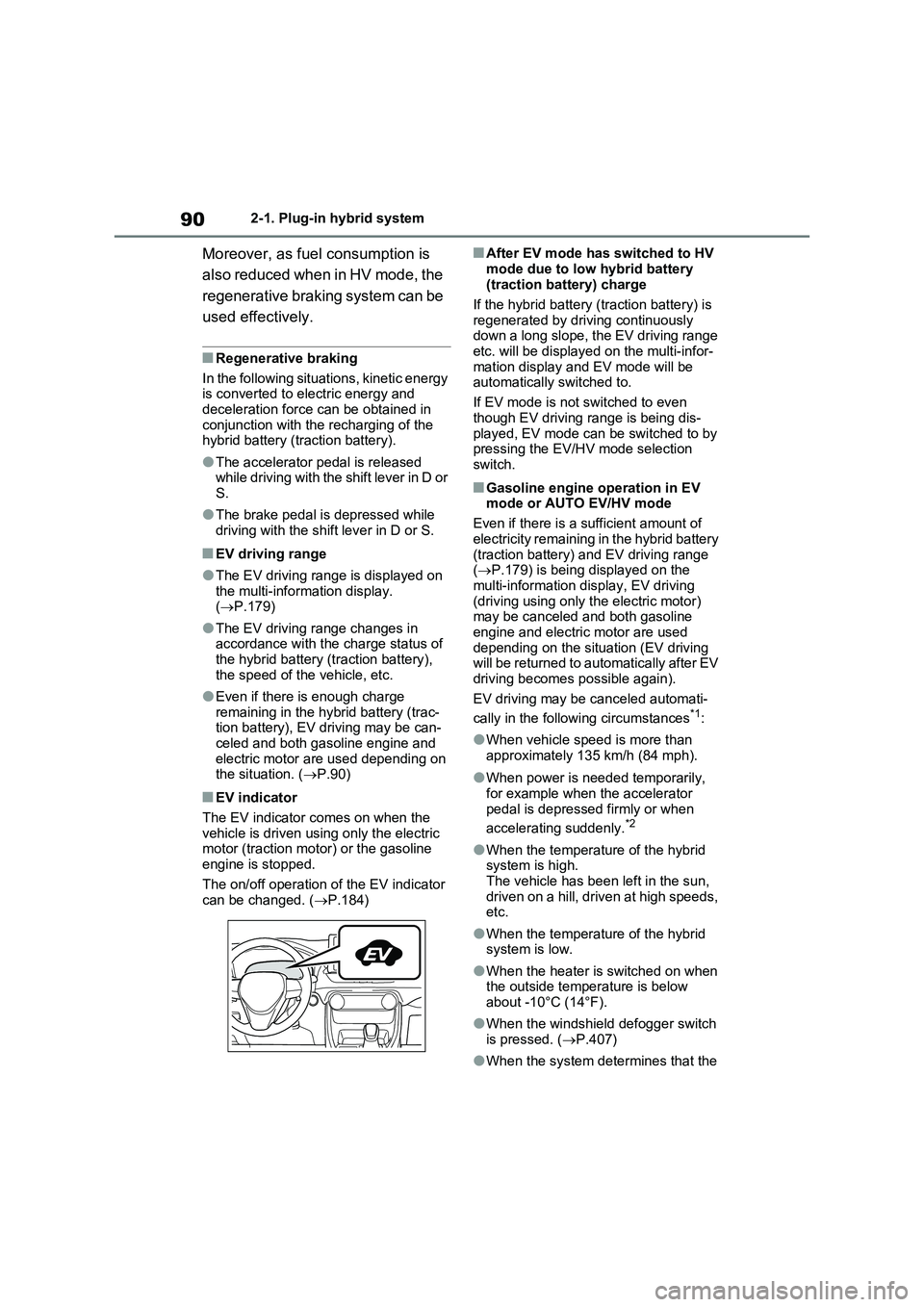
902-1. Plug-in hybrid system
Moreover, as fuel consumption is
also reduced when in HV mode, the
regenerative braking system can be
used effectively.
�QRegenerative braking
In the following situations, kinetic energy
is converted to electric energy and
deceleration force can be obtained in
conjunction with the recharging of the
hybrid battery (traction battery).
�OThe accelerator pedal is released
while driving with the shift lever in D or
S.
�OThe brake pedal is depressed while
driving with the shift lever in D or S.
�QEV driving range
�OThe EV driving range is displayed on
the multi-information display.
(P.179)
�OThe EV driving range changes in
accordance with the charge status of
the hybrid battery (traction battery),
the speed of the vehicle, etc.
�OEven if there is enough charge
remaining in the hybrid battery (trac-
tion battery), EV driving may be can-
celed and both gasoline engine and
electric motor are used depending on
the situation. (P.90)
�QEV indicator
The EV indicator comes on when the
vehicle is driven using only the electric
motor (traction motor) or the gasoline
engine is stopped.
The on/off operation of the EV indicator
can be changed. (P.184)
�QAfter EV mode has switched to HV
mode due to low hybrid battery
(traction battery) charge
If the hybrid battery (traction battery) is
regenerated by driving continuously
down a long slope, the EV driving range
etc. will be displayed on the multi-infor-
mation display and EV mode will be
automatically switched to.
If EV mode is not switched to even
though EV driving range is being dis-
played, EV mode can be switched to by
pressing the EV/HV mode selection
switch.
�QGasoline engine operation in EV
mode or AUTO EV/HV mode
Even if there is a sufficient amount of
electricity remaining in the hybrid battery
(traction battery) and EV driving range
(P.179) is being displayed on the
multi-information display, EV driving
(driving using only the electric motor)
may be canceled and both gasoline
engine and electric motor are used
depending on the situation (EV driving
will be returned to automatically after EV
driving becomes possible again).
EV driving may be canceled automati-
cally in the following circumstances
*1:
�OWhen vehicle speed is more than
approximately 135 km/h (84 mph).
�OWhen power is needed temporarily,
for example when the accelerator
pedal is depressed firmly or when
accelerating suddenly.
*2
�OWhen the temperature of the hybrid
system is high.
The vehicle has been left in the sun,
driven on a hill, driven at high speeds,
etc.
�OWhen the temperature of the hybrid
system is low.
�OWhen the heater is switched on when
the outside temperature is below
about -10°C (14°F).
�OWhen the windshield defogger switch
is pressed. (P.407)
�OWhen the system determines that the